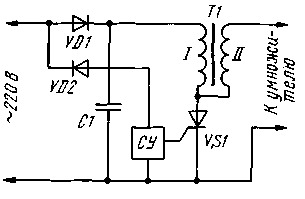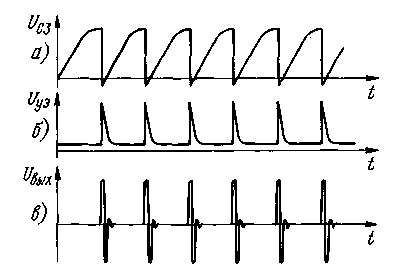Most devices designed for high voltage supply "Chizhevsky Chandelier" can be divided into voltage transistor chopper and trinistorny (and sometimes thyristor, because they use varieties of this group: diacs, triacs, triacs) switching converters. The first disadvantage is the need of lowering and rectifying the mains voltage, which increases both cost and size of the device. Trinistorny devices [1 - 3] is relatively simple, and that is the main argument in their favor. As a rule, work trinistorny the device according to the principle of half-wave discharger (Fig.1).

For one half-line voltage storage capacitor C1 is charged, while the other is discharged to the coil of the boosting transformer T1 through SCR VS1, which is enabled by the control system (CS). The differences sometimes are limited to the method of controlling the SCR. The main drawback of such structures, according to the author, is to lower the frequency of the supply voltage multiplier, which can lead to increased ripple at the output of the unit and reduce the efficiency of "chandelier" [4]. In addition, sometimes you can see the increased noise level of the transformer, which is a consequence of large amplitude current pulses. All this the author managed to avoid by developing a power supply with a circuit (without high voltage multiplier) is shown in Fig.2.

We will consider its work.
Mains voltage is rectified by a diode bridge VD1. The rectified voltage ripple smoothing capacitor C1, the charging current of the capacitor at the moment of switching devices in the network limits the resistor R1. Through a resistor R3 to charge the capacitor CP. At the same time comes into action pulse generator, which is made on the unijunction transistor VT1. His "trigger"the capacitor is charged through resistors R4, R5 from parametric stabilizer, made on the ballast resistor R2 and the Zener diodes VD2, VD3. As the voltage on the capacitor C2 reaches a certain value, "triggered" transistor and managing the transition of SCR enters opening pulse (Fig. 3,b).

Capacitor Sz discharges through the SCR to the primary winding of the transformer (Fig. 3,a). Its secondary winding is formed by a high voltage pulse (Fig. 3,in). The repetition rate of these pulses is determined by the oscillator frequency, which, in turn, depends on the parameters of the chain R4R5C2. A trimming resistor R5 can adjust the output voltage of the unit is about 1.5 times. In this case, the pulse frequency is adjustable 250... 1000 Hz. In addition, the output voltage varies in the selection of the resistor R3 (in the range of 5 to 30 ohms). Output voltage ripple does not exceed 5 %, virtually no interference. Capacitors it is desirable to use paper(S1 and Sz - for a rated voltage not less than 400 V, the same voltage must be rated diode bridge). Is mentioned in the scheme is suitable SCR T10-50, or at least CAN. Zener diodes VD2, VD3-any other, with a total voltage stabilization approximately 18 V. the high-Voltage multiplier can be derived from [1-3]. The transformer is made on the basis of the line TVs-P from black and white TVs, but in principle other [5]. All of the primary winding need to delete and rewind on the freed space 70 turns of wire PEL or sew with a diameter of 0.5...0.8 mm. Increasing the winding (II) should not touch.
Literature
Author: G. gluhenky, Cheboksary; Publication: N. Bolshakov, rf.atnn.ru






